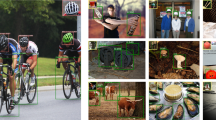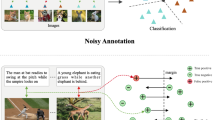Abstract
Partial multi-label learning is of great significant interest due to accurate supervision is difficult to be obtained. Recently, multi-view learning has been developed to deal with partial multi-label learning tasks. Although few multi-view partial multi-label learning methods have been proposed, all of them are designed under the full-view assumption. However, due to the difficulties in multi-view data collection, some views may not contain complete information in real task. The appearance of missing views will affect the performance of traditional partial multi-label learning algorithms. To solve this problem, we propose a novel I ncomplete M ulti-V iew P artial M ulti-L abel learning (IMVPML) framework which makes use of incomplete multi-view feature representation and utilizes the low-rank and sparse decomposition scheme to remove the noisy labels. Specifically, we first learn a shared subspace across heterogenous incomplete views. Secondly, we utilize the low-rank and sparse decomposition scheme to obtain the ground-truth labels. Thirdly, we introduce a graph Laplacian regularization to constrain the ground-truth labels and impose orthogonality constraints on the correlations between subspace. Finally, a predictive model is learned by shared subspace and disambiguation labels. Enormous experimental results demonstrate that the proposed method can achieve competitive performance in solving the problem of incomplete multi-view partial multi-label learning.





Similar content being viewed by others
References
Bertsekas D (1997) Nonlinear programming. J Oper Res Soc 48(3):334–334
Boyd S, Vandenberghe L (2014) Convex Optimization. Cambridge University Press
Cai J, Candės E J, Shen Z (2010) A singular value thresholding algorithm for matrix completion. SIAM J Optim 20(4):1956– 1982
Chen Z, Wu X, Chen Q, Hu Y, Zhang M (2020) Multi-view partial multi-label learning with graph-based disambiguation. In: AAAI Conference on Artificial Intelligence, pp 3553–3560
Demsar J (2006) Statistical comparisons of classifiers over multiple data sets. J Mach Learn Res 7:1–30
Fang J, Zhang M (2019) Partial multi-label learning via credible label elicitation. In: AAAI Conference on Artificial Intelligence, pp 3518–3525
Gibaja E, Ventura S (2015) A tutorial on multilabel learning. ACM Comput Surv 47(3):52:1–52:38
Guillaumin M, Verbeek JJ, Schmid C (2010) Multimodal semi-supervised learning for image classification. In: IEEE Conference on Computer Vision and Pattern Recognition, IEEE Computer Society, pp 902–909
He S, Deng K, Li L, Shu S, Liu L (2019) Discriminatively relabel for partial multi-label learning. In: IEEE International Conference on Data Mining, pp 280–288
Li Z, Lyu G, Feng S (2020) Partial multi-label learning via multi-subspace representation. In: Proceedings of International Joint Conference on Artificial Intelligence, pp 2612–2618
Lin Z, Liu R, Su Z (2011) Linearized alternating direction method with adaptive penalty for low-rank representation. In: Annual Conference on Neural Information Processing Systems, pp 612–620
Liu G, Lin Z, Yan S, Sun J, Yu Y, Ma Y (2013) Robust recovery of subspace structures by low-rank representation. IEEE Trans Pattern Anal Mach Intell 35(1):171–184
Lyu G, Feng S, Li Y (2020) Partial multi-label learning via probabilistic graph matching mechanism. In: ACM SIGKDD Conference on Knowledge Discovery and Data Mining, Virtual Event, pp 105–113
Lyu G, Feng S, Li Y (2021) Noisy label tolerance: A new perspective of partial multi-label learning. Inf Sci 543:454–466
Sun L, Feng S, Wang T, Lang C, Jin Y (2019) Partial multi-label learning by low-rank and sparse decomposition. In: AAAI Conference on Artificial Intelligence, pp 5016–5023
Sun L, Feng S, Lyu G, Zhang H, Dai G (2021) Partial multi-label learning with noisy side information. Knowl Inf Syst 63(2):541–564
Sun S, Zong D (2020) Lcbm: a multi-view probabilistic model for multi-label classification. IEEE Trans Pattern Anal Mach Intell:1–1
Tan Q, Yu G, Domeniconi C, Wang J, Zhang Z (2018) Incomplete multi-view weak-label learning. In: Proceedings of International Joint Conference on Artificial Intelligence, pp 2703–2709
Tan Q, Yu G, Wang J, Domeniconi C, Zhang X (2019) Individuality- and commonality-based multiview multilabel learning. IEEE Trans. Cybern. PP(99):1–12
Wang H, Yang Y, Liu B, Fujita H (2019) A study of graph-based system for multi-view clustering. Knowl Based Syst 163:1009–1019
Wang Y, Zhang Y (2013) Nonnegative matrix factorization: A comprehensive review. IEEE Trans Knowl Data Eng 25(6):1336–1353
Wu J, Wu X, Chen Q, Hu Y, Zhang M (2020) Feature-induced manifold disambiguation for multi-view partial multi-label learning. In: ACM SIGKDD Conference on Knowledge Discovery and Data Mining, pp 557–565
Xiao Q, Dai J, Luo J, Fujita H (2019) Multi-view manifold regularized learning-based method for prioritizing candidate disease mirnas. Knowl Based Syst 175:118–129
Xie M, Huang S (2018) Partial multi-label learning. In: Proceedings of AAAI Conference on Artificial Intelligence, pp 4302–4309
Xie M, Huang S (2020) Partial multi-label learning with noisy label identification. In: AAAI Conference on Artificial Intelligence, pp 6454–6461
Xu C, Tao D, Xu C (2015) Multi-view learning with incomplete views. IEEE Trans Image Process 24(12):5812–5825
Xu N, Liu Y, Geng X (2020) Partial multi-label learning with label distribution. In: The AAAI Conference on Artificial Intelligence, pp 6510–6517
Yi Z, Yang Y, Li T, Fujita H (2019) A multitask multiview clustering algorithm in heterogeneous situations based on LLE and LE. Knowl Based Syst 163:776–786
Yu G, Chen X, Domeniconi C, Wang J, Li Z, Zhang Z, Wu X (2018) Feature-induced partial multi-label learning. In: IEEE International Conference on Data Mining, pp 1398– 1403
Zhang B, Qiang Q, Wang F, Nie F (2020a) Fast multi-view semi-supervised learning with learned graph. IEEE Trans Knowl Data Eng:1–1
Zhang M, Zhou Z (2014) A review on multi-label learning algorithms. IEEE Trans Knowl Data Eng 26(8):1819–1837
Zhang Q, Zhong Y, Zhang M (2018) Feature-induced labeling information enrichment for multi-label learning. In: Mcilraith SA, Weinberger K Q (eds) Proceedings of AAAI Conference on Artificial Intelligence. AAAI Press, pp 4446–4453
Zhang X, Yang Y, Li T, Zhang Y, Wang H, Fujita H (2021) CMC: A consensus multi-view clustering model for predicting alzheimer’s disease progression. Comput Methods Programs Biomed 199:105895
Zhang Y, Shi D, Gao J, Cheng D (2017) Low-rank-sparse subspace representation for robust regression. In: IEEE Conference on Computer Vision and Pattern Recognition, pp 2972–2981
Zhang Y, Wu J, Cai Z, Yu P S (2020b) Multi-view multi-label learning with sparse feature selection for image annotation. IEEE Trans Multimed 22(11):2844–2857
Zhu Y, Kwok J T, Zhou Z (2018) Multi-label learning with global and local label correlation. IEEE Trans Knowl Data Eng 30(6):1081–1094
Acknowledgements
This work was supported in part by the National Natural Science Foundation of China (No.61872032), the Beijing Natural Science Foundation (No. 4202058), the Fundamental Research Funds for the Central universities (2019JBM020), and in part by the National Key Research and Development Project (No. 2018AAA0100300).
Author information
Authors and Affiliations
Corresponding author
Additional information
Publisher’s note
Springer Nature remains neutral with regard to jurisdictional claims in published maps and institutional affiliations.
Xinyuan Liu and Lijuan Sun contributed the work equally.
Rights and permissions
About this article
Cite this article
Liu, X., Sun, L. & Feng, S. Incomplete multi-view partial multi-label learning. Appl Intell 52, 3289–3302 (2022). https://doi.org/10.1007/s10489-021-02606-w
Accepted:
Published:
Issue Date:
DOI: https://doi.org/10.1007/s10489-021-02606-w




